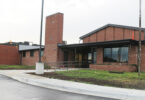by Joe Bollig
joe.bollig@theleaven.org
KANSAS CITY, Kan. — Albert Einstein was famously quoted as saying: “God does not play dice with the universe.”
In other words, there are no coincidences when God is involved. As St. Paul wrote:
“All things work together for good for those who love God” (Rom 8:28).
So it was probably no coincidence at all that while Austrian Cardinal Christopher Schönborn visited the archdiocese Jan. 30-31, one of the foremost lay authorities on the Catechism of the Catholic Church was here as well.
Petroc Willey, deputy director of the Maryvale Institute in the Archdiocese of Birmingham in the United Kingdom, was at Savior Pastoral Center in Kansas City, Kan., when Cardinal Schönborn arrived.
Willey and the cardinal know each other well. The cardinal’s work has been vital in fostering a new “springtime of catechesis” in the church, said Willey. And the cardinal is a Maryvale supporter, as well as a patron of its journal, The Sower, which is edited by Willey.
Willey was here in the archdiocese as part of a group of Maryvale instructors. The educators presented a study day on Jan. 30 for students who are working toward the certificate in catechesis or master’s degree offered by the Maryvale Institute to archdiocesan students.
Maryvale grew out of the Archdiocese of Birmingham’s efforts to support religious education in its parishes through long-distance learning programs.
“We can’t possibly reach all the parishes and support the catechists in their very many and varied needs by traveling around,” said Willey.
“And so,” he continued, “we’ve been determined to provide educative materials which they can use wherever they are, and which can support them in their own study, at their own pace.”
It is from this basic idea that Maryvale grew into an international institute with students in places as far-flung as Africa, Norway, the United Arab Emirates, and the United States.
In the Archdiocese of Kansas City in Kansas, 22 students are studying to earn a certificate in catechesis, and 12 are studying for a master’s in religious education and catechesis.
“[Cardinal Schönborn] has been a very important figure of inspiration over the years, and he has supported the founding of ‘amicitia catechistica,’ which means ‘catechetical friendship,’” said Willey. “It is the idea that the handing on of the faith has to be done through personal relationships and friendships.”
Cardinal Schönborn nurtured this amicitia catechistica by promoting a relationship between Maryvale, the Franciscan University of Steubenville, Ohio, and the Studium of Notre-Dame de Vie in Venasque, France.
“It has been for us very inspiring to have such a sense of kindred spirits with members of the archdiocese here, to share in that work,” said Willey. “I want to say that, because it’s a very special place for catechesis, this archdiocese.”
Catechesis has taken many forms since the Second Vatican Council, said Willey. Some have been more successful than others.
“The thing to remember is that the Second Vatican Council is the catechetical council,” said Willey “It was called — unlike any other council in history — not to correct a problem or oppose a heresy, but purely to promote the catechetical and pastoral work of the church. The whole of its focus was on how to hand on the faith organically, beautifully, and faithfully in today’s world.”
And while there have been some “false turnings” in catechesis since the council, he said, the magisterium of the church has also produced a number of key documents to help guide the church.
These key documents include Pope John Paul II’s 1979 apostolic exhortation “Catechesi Tradendae” (“On Catechesis in Our Time”), the “General Catechetical Directory” in 1971, the “General Directory for Catechesis” in 1997, and in the United States, the “National Directory of Catechesis” in 2003.
By far, however, the most important document was the catechism, published in 1997.
“The Holy Father, Pope John Paul II, in his introduction to the catechism, said he was looking for a catechesis renewed in the living sources of the faith,” said Willey.
“That’s because these sources — Scripture and [sacred] Tradition — are Spirit-filled,” he continued. “So, the basic methodology is not so much just to deliver content. It is to enable adults to be touched and transformed by the actual sources of the renewal of the faith through which God works.”
When people become exposed to these living sources of the faith, their lives are transformed, he said. The church is seeing the fruits of these transformed lives through renewed catechetical efforts.
“You can also see a growing number of very mature young people who are seeking a richer form of the faith and are increasingly trusting the church to give them the bread they are seeking,” said Willey.






